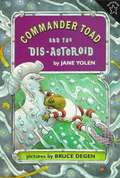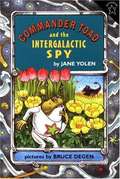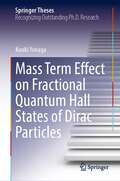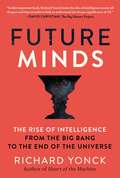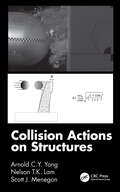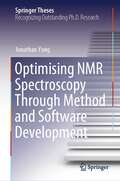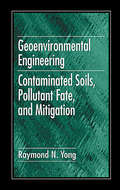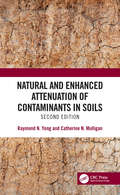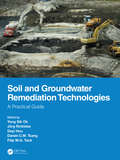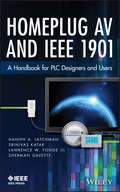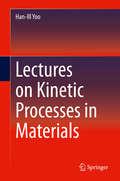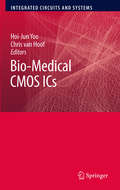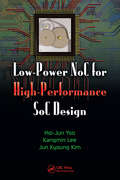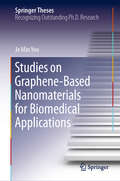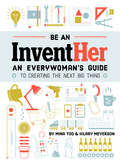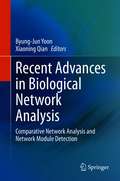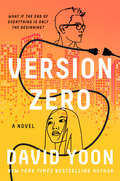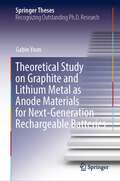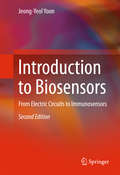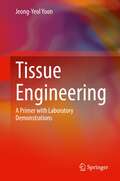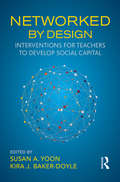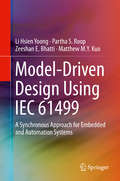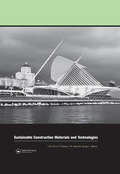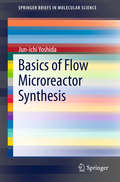- Table View
- List View
Commander Toad and the Dis-asteroid (Commander Toad #4)
by Jane YolenYoung fans of Star Wars and silliness will toad-ally love Commander Toad! When Commander Toad and the crew of the Star Warts learn that a disaster has struck an asteroid, they race across the galaxy to the rescue. But it's hard to figure out just what is wrong, especially when there is a language barrier between the Star Warts' crew and the pigeon inhabitants of the dis-asteroid. A hero is needed, but is even intrepid Commander Toad brave enough to save the day?
Commander Toad and the Intergalactic Spy (Commander Toad #5)
by Jane YolenCommander Toad and the crew of Star Warts are asked to rout out Tip Toad, Space Fleet's greatest and most elusive spy.
Mass Term Effect on Fractional Quantum Hall States of Dirac Particles (Springer Theses)
by Kouki YonagaThis book presents the high-precision analysis of ground states and low-energy excitations in fractional quantum Hall states formed by Dirac electrons, which have attracted a great deal of attention. In particular the author focuses on the physics of fractional quantum Hall states in graphene on a hexagonal boron nitride substrate, which was recently implemented in experiments. The numerical approach employed in the book, which uses an exact numerical diagonalization of an effective model Hamiltonian on a Haldane’s sphere based on pseudopotential representation of electron interaction, provides a better understanding of the recent experiments. The book reviews various aspects of quantum Hall effect: a brief history, recent experiments with graphene, and fundamental theories on integer and fractional Hall effects. It allows readers to quickly grasp the physics of quantum Hall states of Dirac fermions, and to catch up on latest research on the quantum Hall effect in graphene.
Future Minds: The Rise of Intelligence from the Big Bang to the End of the Universe
by Richard YonckFor Readers of Michio Kaku and Stephen Hawking, an Epic Journey through the Intelligent Universe With the ongoing advancement of AI and other technologies, our world is becoming increasingly intelligent. From chatbots to innovations in brain-computer interfaces to the possibility of superintelligences leading to the Singularity later this century, our reality is being transformed before our eyes. This is commonly seen as the natural result of progress, but what if there&’s more to it than that? What if intelligence is an inevitability, an underlying property of the universe? In Future Minds, Richard Yonck challenges our assumptions about intelligence—what it is, how it came to exist, its place in the development of life on Earth and possibly throughout the cosmos. Taking a Big History perspective—over the 14 billion years from the Big Bang to the present and beyond—he draws on recent developments in physics and complexity theory to explore the questions: Why do pockets of increased complexity develop, giving rise to life, intelligence, and civilization? How will it grow and change throughout this century, transforming both technology and humanity? As we expand outward from our planet, will we discover other forms of intelligence, or will we conclude we are destined to go it alone? Any way we look at it, the nature of intelligence in the universe is becoming a central concern for humanity. Ours. Theirs. And everything in between.
Collision Actions on Structures
by Arnold C.Y. Yong Nelson T.K. Lam Scott J. MenegonThis textbook covers the collision of a moving, falling or flying object on a rigid barrier or a structural element, and the transmission of the transient action to the rest of the structural system. It is the only up-to-date book on this under-researched topic that confronts engineers on a day-to-day basis. The book deals with a range of real-life engineering problems and focuses on the application of knowledge and skillsets from structural analysis and structural dynamics. Fundamental principles and concepts on structural collision are first introduced, followed by their specific applications such as vehicular collision on bridge structures, boulder impact on rockfall barriers and collision by hail and windborne debris. Analytical solutions provided are in the form of closed-form expressions, which can be directly adopted in conventional manual calculations. The use of spreadsheets to simulate the dynamic response behaviour is also covered. • The only standalone book covering the topic from a civil engineering perspective • Practical guidance on real-life engineering problems, and use of computational and physical methods • Conveys methodology validated experimentally The book provides an excellent guide for practitioners and sets out fundamental principles for graduate students in civil, structural and mechanical engineering.
Optimising NMR Spectroscopy Through Method and Software Development (Springer Theses)
by Jonathan YongThis book provides a comprehensive overview of Nuclear Magnetic Resonance (NMR) theory, its applications, and advanced techniques to improve the quality and speed of NMR data acquisition. In this book, the author expands his outstanding Ph.D. thesis and provides a valuable resource for researchers, professionals, and students in the field of NMR spectroscopy. The book covers quantum mechanics basics, and topics like density operators, pulse sequences, 1D pulse acquisition, INEPT (Insensitive nuclei enhancement by polarization transfer), product operators, and 2D NMR principles. It also explores innovative experiments like States HSQC (Heteronuclear Single Quantum Coherence) and echo-antiecho HSQC with gradients. In the subsequent chapters, the author discusses Pure Shift NMR, including PSYCHE (Pure Shift Yielded by Chirp Excitation) and its optimizations, such as waveform parameterization and time-reversal methods. The 'Discrete PSYCHE' approach and Ultrafast PSYCHE-iDOSY (Diffusion-ordered spectroscopy) are also highlighted. This book presents the POISE (Parameter Optimisation by Iterative Spectral Evaluation) software for real-time NMR experiment optimization, including pulse width calibration and Ernst angle optimization, and demonstrates applications across various NMR experiments. Lastly, the book examines accelerated 2D NMR data collection and the NOAH (NMR by Ordered Acquisition using 1H detection) supersequences, emphasizing automated pulse program creation using GENESIS (GENEration of Supersequences In Silico). Covered NMR experiments include 13C sensitivity-enhanced HSQC, 15N HMQC (Heteronuclear Multiple Quantum Coherence), dual HSQC, HSQC-TOCSY (Total Correlation Spectroscopy), HMBC (Heteronuclear Multiple Bond Correlation), and ADEQUATE (Adequate Sensitivity Double-Quantum Spectroscopy).
Geoenvironmental Engineering: Contaminated Soils, Pollutant Fate, and Mitigation
by Raymond N. YongGeoenvironmental Engineering: Contaminated Soils, Pollutant Fate, and Mitigation focuses on why soils and sediments remain contaminated. The reader will understand why specific contaminants remain in soils and sediments, how much of a threat they pose to human health and the environment, and what steps to take for mitigation. Subjects covered include the basic properties of soils affecting accumulation of contaminants, long-term retention of contaminants and their fate, including the development of intermediate products. The author emphasizes the factors, interactions, and mechanisms important in the bonding and partitioning process.
Natural and Enhanced Attenuation of Contaminants in Soils, Second Edition
by Raymond N. Yong Catherine N. MulliganNatural attenuation has become an effective and low-cost alternative to more expensive engineered remediation. This new edition updates the principles and fundamentals of natural attenuation of contaminants with a broader view of the field. It includes new methods for evaluating natural attenuation mechanisms and microbial activity at the lab and field scales. Case studies, actual treatments and protocols, theoretical processes, case studies, numerical models, and legal aspects in the natural attenuation of organic and inorganic contaminants are examined. Challenges and future directions for the implementation of natural attenuation and enhanced remediation techniques are also considered.
Soil and Groundwater Remediation Technologies: A Practical Guide
by Yong Sik Ok; Jörg Rinklebe; Deyi Hou; Daniel C.W. Tsang; Filip M.G. TackThis book offers various soil and water treatment technologies due to increasing global soil and water pollution. In many countries, the management of contaminated land has matured, and it is developing in many others. Topics covered include chemical and ecological risk assessment of contaminated sites; phytomanagement of contaminants; arsenic removal; selection and technology diffusion; technologies and socio-environmental management; post-remediation long-term management; soil and groundwater laws and regulations; and trace element regulation limits in soil. Future prospects of soil and groundwater remediation are critically discussed in this book. Hence, readers will learn to understand the future prospects of soil and groundwater contaminants and remediation measures.Key Features: Discusses conventional and novel aspects of soil and groundwater remediation technologies Includes new monitoring/sensing technologies for soil and groundwater pollution Features a case study of remediation of contaminated sites in the old, industrial, Ruhr area in Germany Highlights soil washing, soil flushing, and stabilization/solidification Presents information on emerging contaminants that exhibit new challenges This book is designed for undergraduate and graduate courses and can be used as a handbook for researchers, policy makers, and local governmental institutes. Soil and Groundwater Remediation Technologies: A Practical Guide is written by a team of leading global experts in the field.
Homeplug AV and IEEE 1901
by Larry Yonge Sherman Gavette Srinivas Katar Haniph A. LatchmanThe only authorized book explaining the HomePlug networking standardsHomePlug is a growing technology for creating high-speed Power Line Communication (PLC) networks by transmitting data over in-home or in-office power lines. Users only need to plug adapters into wall outlets to create an instant network of computers, printers, routers, home entertainment devices, and appliance control systems.HomePlug AV and IEEE 1901: A Handbook for PLC Designers and Users provides for the first time an opportunity for non-members of the HomePlug Alliance to gain in-depth insight into the design and operation of the HomePlug standards. Offering a clear and simple description of the standards, this groundbreaking resource presents HomePlug AV and the associated IEEE 1901 standards in terms more readily understood by a much wider audience, including nontechnical managers, engineers, students, and HomePlug designers.The book details the many benefits of HomePlug AV, including:An affordable, secure alternative or complement to WiFi--especially in buildings where WiFi reception is poor or running new network wires is impracticalHigher potential data transmission rates up to 200 MbpsSupport for multimedia applications such as HDTV and VoIPThe book also provides an overview of the HomePlug Green PHY standard that is targeted for use in smart energy applications, and the HomePlug AV 2.0 standard that operates at up to 1.5 Gbps.An essential tool for designers of HomePlug devices, network administrators, and individual users of HomePlug networks who need to understand the features and capabilities of HomePlug, HomePlug AV and IEEE 1901: A Handbook for PLC Designers and Users will also prove useful for researchers in academia and the power line communications industry.
Lectures on Kinetic Processes in Materials
by Han-Ill YooThis book provides beginning graduate or senior-level undergraduate students in materials disciplines with a primer of the fundamental and quantitative ideas on kinetic processes in solid materials. Kinetics is concerned with the rate of change of the state of existence of a material system under thermodynamic driving forces. Kinetic processes in materials typically involve chemical reactions and solid state diffusion in parallel or in tandem. Thus, mathematics of diffusion in continuum is first dealt with in some depth, followed by the atomic theory of diffusion and a brief review of chemical reaction kinetics. Chemical diffusion in metals and ionic solids, diffusion-controlled kinetics of phase transformations, and kinetics of gas-solid reactions are examined. Through this course of learning, a student will become able to predict quantitatively how fast a kinetic process takes place, to understand the inner workings of the process, and to design the optimal process of material state change.Provides students with the tools to predict quantitatively how fast a kinetic process takes place and solve other diffusion related problems;Learns fundamental and quantitative ideas on kinetic processes in solid materials;Examines chemical diffusion in metals and ionic solids, diffusion-controlled kinetics of phase transformations, and kinetics of gas-solid reactions, among others;Contains end-of chapter exercise problems to help reinforce students' grasp of the concepts presented within each chapter.
Bio-Medical CMOS ICs (Integrated Circuits and Systems)
by Hoi-Jun Yoo Chris Van HoofThis book is based on a graduate course entitled, Ubiquitous Healthcare Circuits and Systems, that was given by one of the editors at his university. It includes an introduction and overview to the field of biomedical ICs and provides information on the current trends in research. The material focuses on the design of biomedical ICs rather than focusing on how to use prepared ICs.
Low-Power NoC for High-Performance SoC Design (System-on-Chip Design and Technologies)
by Hoi-Jun Yoo Kangmin Lee Jun Kyong KimChip Design and Implementation from a Practical Viewpoint Focusing on chip implementation, Low-Power NoC for High-Performance SoC Design provides practical knowledge and real examples of how to use network on chip (NoC) in the design of system on chip (SoC). It discusses many architectural and theoretical studies on NoCs, including design methodology, topology exploration, quality-of-service guarantee, low-power design, and implementation trials. The Steps to Implement NoC The book covers the full spectrum of the subject, from theory to actual chip design using NoC. Employing the Unified Modeling Language (UML) throughout, it presents complicated concepts, such as models of computation and communication–computation partitioning, in a manner accessible to laypeople. The authors provide guidelines on how to simplify complex networking theory to design a working chip. In addition, they explore the novel NoC techniques and implementations of the Basic On-Chip Network (BONE) project. Examples of real-time decisions, circuit-level design, systems, and chips give the material a real-world context. Low-Power NoC and Its Application to SoC Design Emphasizing the application of NoC to SoC design, this book shows how to build the complicated interconnections on SoC while keeping a low power consumption.
Studies on Graphene-Based Nanomaterials for Biomedical Applications (Springer Theses)
by Je Min YooThis thesis presents various applications of graphene-based nanomaterials, especially in biomedicine. Graphene and its derivatives have gained enormous attention from scientists in all fields of study due to many unprecedented properties. The initial scientific attention was focused on the development of transparent flexible electrodes by exploiting two-dimensional graphene film’s extraordinary electrical and physical properties. Recently, given an increasing evidence of dispersed graphene-based nanomaterials’ biocompatibility, researchers have endeavored to employ these materials in other studies relevant to biomedical technologies. In this respect, the thesis provides a comprehensive review on the synthesis, toxicity, and a few of the key biomedical applications in the first chapter. The following chapter discusses the use of a graphene film as a novel catalyst to oxidatively destroy phenols, which are known to be potentially mutagenic and carcinogenic. Finally, and most importantly, the last chapter introduces the therapeutic role of graphene quantum dots, the smallest graphene-based nanomaterials, for Parkinson’s disease. The results are promising for the use of graphene quantum dots as the basis of future clinical drug candidates for neurodegenerative disorders.
Be an InventHer: An Everywoman's Guide to Creating the Next Big Thing
by Mina Yoo Hilary MeyersonBe an InventHER is a complete guide to inventing, geared toward any woman who wants to bring her invention, innovation, or creation from idea to the marketplace.Authors Mina Yoo and Hilary Meyerson offer practical advice to any woman looking to take an invention from idea to market. Walking you through the entire process, they offer encouragement, success stories of other female inventors, and concrete guidance to help readers realize their dreams of invention. Inventing and innovation is a hot topic, and this book--coauthored by a woman who created a successful business that started as a sketch on a cocktail napkin--offers a helping hand through the invention process without intimidation or undue complication.
Recent Advances in Biological Network Analysis: Comparative Network Analysis and Network Module Detection
by Byung-Jun Yoon Xiaoning QianThis book reviews recent advances in the emerging field of computational network biology with special emphasis on comparative network analysis and network module detection. The chapters in this volume are contributed by leading international researchers in computational network biology and offer in-depth insight on the latest techniques in network alignment, network clustering, and network module detection. Chapters discuss the advantages of the respective techniques and present the current challenges and open problems in the field. Recent Advances in Biological Network Analysis: Comparative Network Analysis and Network Module Detection will serve as a great resource for graduate students, academics, and researchers who are currently working in areas relevant to computational network biology or wish to learn more about the field. Data scientists whose work involves the analysis of graphs, networks, and other types of data with topological structure or relations can also benefit from the book's insights.
Version Zero
by David YoonFrom the brilliant mind of New York Times bestselling author David Yoon comes a lightning-fast and scorchingly observant thriller about how we can save ourselves from the very real perils of a virtual world.Max, a data whiz at the social media company Wren, has gotten a firsthand glimpse of the dark side of big tech. When he questions what his company does with the data they collect, he's fired...then black-balled across Silicon Valley. With time on his hands and revenge on his mind, Max and his longtime friend (and secretly the love of his life) Akiko, decide to get even by rebooting the internet. After all, in order to fix things, sometimes you have to break them. But when Max and Akiko join forces with a reclusive tech baron, they learn that breaking things can have unintended--and catastrophic--consequences.
Theoretical Study on Graphite and Lithium Metal as Anode Materials for Next-Generation Rechargeable Batteries (Springer Theses)
by Gabin YoonThis thesis describes in-depth theoretical efforts to understand the reaction mechanism of graphite and lithium metal as anodes for next-generation rechargeable batteries. The first part deals with Na intercalation chemistry in graphite, whose understanding is crucial for utilizing graphite as an anode for Na-ion batteries. The author demonstrates that Na ion intercalation in graphite is thermodynamically unstable because of the unfavorable Na-graphene interaction. To address this issue, the inclusion of screening moieties, such as solvents, is suggested and proven to enable reversible Na-solvent cointercalation in graphite. Furthermore, the author provides the correlation between the intercalation behavior and the properties of solvents, suggesting a general strategy to tailor the electrochemical intercalation chemistry. The second part addresses the Li dendrite growth issue, which is preventing practical application of Li metal anodes. A continuum mechanics study considering various experimental conditions reveals the origins of irregular growth of Li metal. The findings provide crucial clues for developing effective counter strategies to control the Li metal growth, which will advance the application of high-energy-density Li metal anodes.
Introduction to Biosensors
by Jeong-Yeol YoonBiosensors: From Electric Circuits to Immunosensors discusses underlying circuitry of sensors for biomedical and biological engineers as well as biomedical sensing modalities for electrical engineers while providing an applications-based approach to the study of biosensors with over 13 extensive, hands-on labs. The material is presented using a building-block approach, beginning with the fundamentals of sensor design and temperature sensors and ending with more complicated biosensors.
Tissue Engineering: A Primer with Laboratory Demonstrations
by Jeong-Yeol YoonTissue Engineering: A Primer with Laboratory Demonstrations concisely covers the fundamental basics of tissue engineering. A series of simple, low-cost, and easy-to-implement laboratory modules are included in each chapter, along with experimental results with actual images and data, and a set of questions and discussion topics for each laboratory exercise. The textbook is appropriate for upper-undergraduate and graduate-level courses in cell and tissue engineering. The inclusion of images and data for all laboratory exercises also makes the book a valuable tool for scientists and engineers to learn the concepts in a hands-on and visual manner and lay a foundation to build their experiments towards their research and commercial development.
Networked By Design: Interventions for Teachers to Develop Social Capital
by Susan A. Yoon Kira J. Baker-DoyleNetworked by Design brings together work from leading international scholars in the learning sciences that applies social network theory to teachers’ social interactions and relationships. The volume examines the direct and indirect relationships and communities that teachers navigate, as well as the models, plans, and other interventions that allow them to exercise control over these networks. Each chapter draws from case studies or latitudinal research to investigate a different intervention and its outcomes. By presenting research conducted in a variety of scales and contexts, this book offers scholars, future teachers, and leaders diverse insights into how interventions in social capital and social networks can create impactful, meaningful teaching and learning.
Model-Driven Design Using IEC 61499
by Li Hsien Yoong Partha S. Roop Zeeshan E. Bhatti Matthew M. Y. KuoThis book describes a novel approach for the design of embedded systems and industrial automation systems, using a unified model-driven approach that is applicable in both domains. The authors illustrate their methodology, using the IEC 61499 standard as the main vehicle for specification, verification, static timing analysis and automated code synthesis. The well-known synchronous approach is used as the main vehicle for defining an unambiguous semantics that ensures determinism and deadlock freedom. The proposed approach also ensures very efficient implementations either on small-scale embedded devices or on industry-scale programmable automation controllers (PACs). It can be used for both centralized and distributed implementations. Significantly, the proposed approach can be used without the need for any run-time support. This approach, for the first time, blurs the gap between embedded systems and automation systems and can be applied in wide-ranging applications in automotive, robotics, and industrial control systems. Several realistic examples are used to demonstrate for readers how the methodology can enable them to reduce the time-to-market, while improving the design quality and productivity.
Sustainable Construction Materials and Technologies: Proceedings of the Conference on Sustainable Construction Materials and Technologies, 11-13 June 2007, Coventry, United Kingdom
by Yoon-moon Chun; Peter Claisse; Tarun R. Naik; Eshmaiel GanjianThe construction materials industry is a major user of the world’s resources. While enormous progress has been made towards sustainability, the scope and opportunities for improvements are significant. To further the effort for sustainable development, a conference on Sustainable Construction Materials and Technologies was held at Coventry University, Coventry, U.K., from June 11th - 13th, 2007, to highlight case studies and research on new and innovative ways of achieving sustainability of construction materials and technologies. This book presents selected, important contributions made at the conference. Over 190 papers from over 45 countries were accepted for presentation at the conference, of which approximately 100 selected papers are published in this book. The rest of the papers are published in two supplementary books. Topics covered in this book include: sustainable alternatives to natural sand, stone, and Portland cement in concrete; sustainable use of recyclable resources such as fly ash, ground municipal waste slag, pozzolan, rice-husk ash, silica fume, gypsum plasterboard (drywall), and lime in construction; sustainable mortar, concrete, bricks, blocks, and backfill; the economics and environmental impact of sustainable materials and structures; use of construction and demolition wastes, and organic materials (straw bale, hemp, etc.) in construction; sustainable use of soil, timber, and wood products; and related sustainable construction and rehabilitation technologies.
Fiscal Vulnerability and Sustainability in Oil-Producing Sub-Saharan African Countries
by Robert York Zaijin ZhanA report from the International Monetary Fund.
Basics of Flow Microreactor Synthesis (SpringerBriefs in Molecular Science)
by Jun-Ichi YoshidaThis book provides in a concise form the principles and applications of flow microreactors in organic and polymer synthesis. Recently, it became possible to conduct chemical reactions in a flow reactor in laboratory synthesis. The flow microreactor enables reactions that cannot be done in batch, opening a new possibility of chemical synthesis. Extremely fast mass and heat transfer and high-resolution residence time control are responsible for the remarkable features of that process. The book is not an exhaustive compilation of all known examples of flow microreactor synthesis. Rather, it is a sampling of sufficient variety to illustrate the concept, the scope, and the current state of flow microreactor synthesis. Researchers both in academia and in industry will be interested in this book because the topics encompassed by the book are vigorously studied in many university and company laboratories today.
